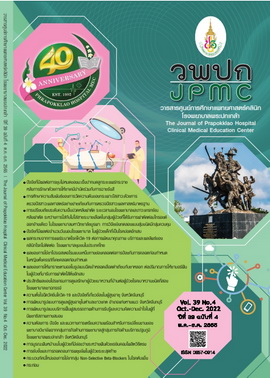Needs, Factors, and Guidelines for the Preparation of the Job Transition from the Departments of Nursing Service to the Departments of Primary Care Service of Professional Nurses, Phrapokklao Hospital, Chanthaburi Province
Main Article Content
Abstract
BACKGROUND: The nurses’ job transition from a hospital to community tasks is necessary for national strategic changes for human resources to be allocated in a timely and effective manner according to the Ministry of Public Health’s policies.
OBJECTIVES: This research aimed to examine the need for the job transition among professional nurses from the Departments of Nursing Service to the Departments of Primary Care Service, Phrapokklao Hospital Chanthaburi Province, Thailand, and to study the factors related to the job transition and guidelines for preparing to change their job.
METHODS: The population of this descriptive study was 790 professional nurses working in the aforementioned hospital. The sample comprised 259 nurses working in the Departments of Nursing Service, and systematic sampling was utilized. The research instrument consisted of three parts as follows: 1) personal data, 2) a job transition questionnaire, and 3) guidelines for the preparation of the job transition. The content validity, which was between 0.6-1.0, was found to be significant. The data were analyzed by descriptive statistics.
RESULTS: The results showed the following: 1) Eighteen percent of professional nurses wished to change their jobs. Most, who were aged between 25 and 34 years (41.7%), wanted to change the jobs after 5-10 working years of service (35.4%). 2) The factors of the job transition comprised three parts: family necessity as the personal factor (68.8%), the nature of the nursing jobs as the internal organizational factor (79.2%), and changing to new workplaces as the external organizational factor (85.4%). The need for changing the position from the Departments of Nursing Service to the Departments of Primary Care Service was a community nursing task (60.4%). 3) The preparation guideline for job transition consisted of two levels: (1) At the Organization level, to define the position framework for the timely support of the job transition (75.0%), and to support the community management methods (77.1%), and (2) at the personal level include capacity building of the knowledge and skill (77.1%,75.0%) and to gain the benefit from a good quality of work life (85.4%).
CONCLUSIONS: This study revealed that one in five professional nurses had a desire to change their jobs to the Departments of Primary Care Service. The personal, internal and external organizational factors were the relevant factors. Furthermore, the preparation for changing jobs involved both the organization and individual levels.
Article Details

This work is licensed under a Creative Commons Attribution-NonCommercial-NoDerivatives 4.0 International License.
References
KakarndeeN. Factors affecting job hopping of generation Y workers. [dissertation]. Bangkok: Thammasat University; 2017.
Vaughn N. Nurse turnover rates: How to reduce healthcare turnover [Internet]. 2020 [cited 2021 Apr10]. Available from: https://www.relias.com/blog/how-to-reduce-healthcare-turnover
Khunthar A, Kedcham D, SawaengdeeK,Theerawit T. Job transfers amongst registered nurses in Thailand. Thai Journal of Nursing Council 2013; 28(3): 19-31.
Ministry of Public Health.The 20-year national strategic plan for public health [Internet].Nonthaburi: Strategy and Planning Division; 2016. [cited 2017 Sep 15]. Available from: https://waa.inter.nstda.or.th/stks/pub/2017/20171117-MinistryofPublicHealth.pdf
Ministry of Public Health. Ministry of Public Health Policy and Strategy 2021-2022 [Internet].Nonthaburi: Ministry of Public Health; 2021 [cited 2021 Apr 10]. Available from: http://www.spko.moph.go.th/wp-content/uploads/2021/09/policy65.pdf
Phanthunane P, Bamrung A, Jirawattanapisal T, Pagaiya N, Khaonuan B, Noree T. A utilization-based model to predict human resources for health (HRH) in secondary care services of Thailand 2026. Journal of Health Systems Research 2018;12:205-20.
Hayes LJ, O'Brien-Pallas L, Duffield C, Shamian J, Buchan J, Hughes F, et al. Nurse turnover: a literature review- an update. Int J Nurs Stud 2012;49:887-905.
Pennbrant S, Dåderman A. Job demands, work engagement and job turnover intentions among registered nurses: Explained by work-family private life inference. Work 2021;68:1157-69.
Sangournpak S. Factors affecting turnover intention of generation z professional nurses in a university hospital[dissertation]. Bangkok: Mahidol University; 2021.
Kusolvisitkul W. Nursing research, statistics and information technology. Nonthaburi: SukhothaiThammathiratUniversity; 2017.
Mobley WH, Griffeth R, Hand HH, Meglino BM. A review and conceptual analysis of the employee turnover process.Psychol Bull 1979;86:493-522.
Holt DT, Armenakis AA, Field HS, Harris SG. Readiness for organizational change the systematic development of a scale. J ApplBehavSci 2007; 43:232-55.
Rattanamanee N, Phasunon P. Response rate in quantitative research. Journal of Humanities and Social Sciences Thonburi University 2019;13(3):181-8.
Office of the civil Service Commission. Standards for the positioning of registered nurses [internet]. 2008 [cited 2020 Dec 20]. Available from: https://www.ocsc.go.th/sites/default/files/attachment/job_specification/3-6-008_0.pdf
Unruh LY, Zhang NJ. Newly licensed registered nurse job turnover and turnover intent. Nurses Prof Dev. 2014;30:220-30.
Katekaew A. Guideline on decreasing staff turnover rate of five stars hotel in Ratchaprasong area, Bangkok [dissertation]. Bangkok: Silpakorn University; 2014.

